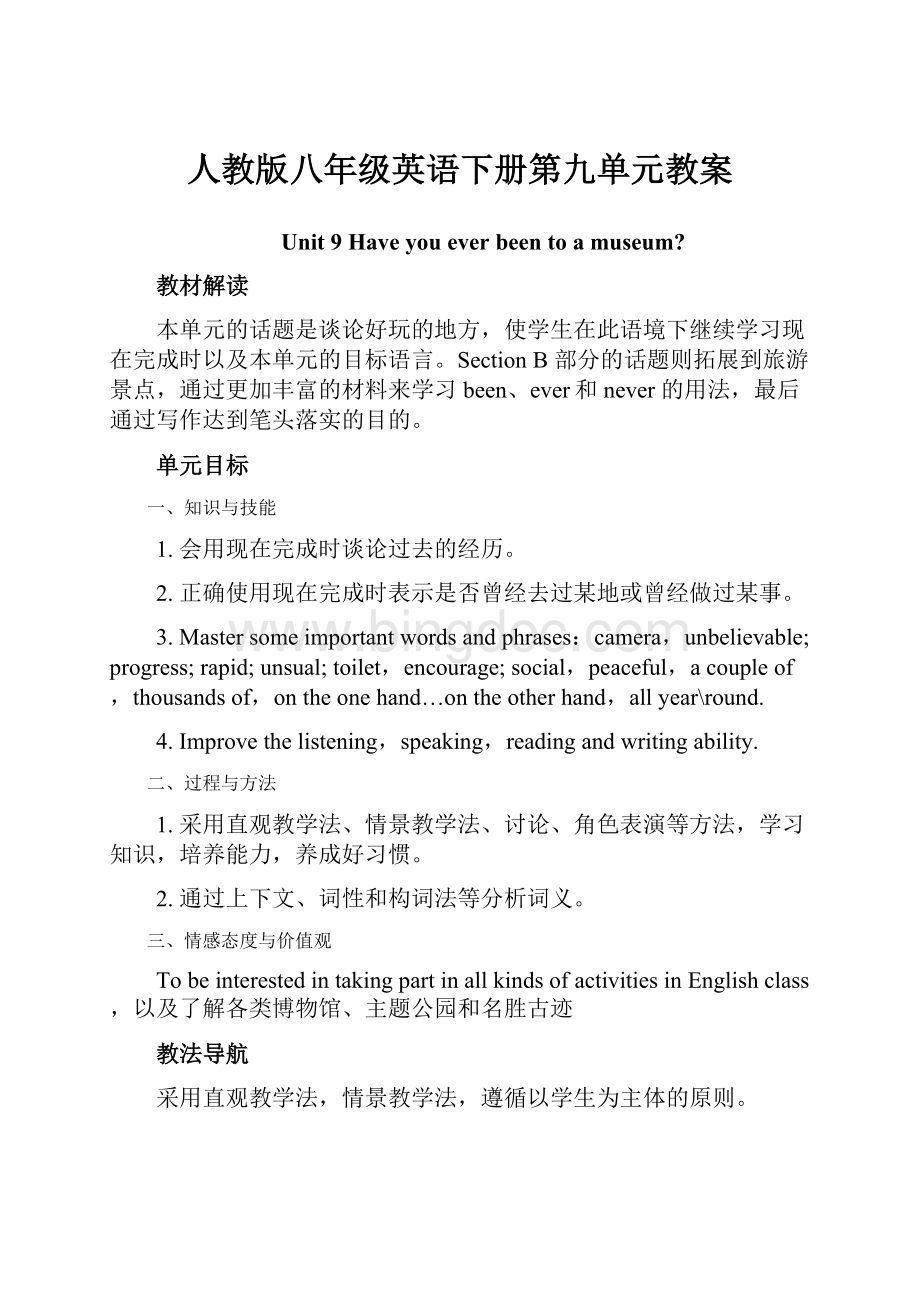人教版八年级英语下册第九单元教案Word文件下载.docx
《人教版八年级英语下册第九单元教案Word文件下载.docx》由会员分享,可在线阅读,更多相关《人教版八年级英语下册第九单元教案Word文件下载.docx(20页珍藏版)》请在冰点文库上搜索。

SectionA1a-2d
第2课时:
SectionA3a-4c
第3课时:
SectionB1a-2e
第4课时:
SectionB3a-SelfCheck
课时教案
第1课时SectionA1a-2d
教学目标
1.Keyvocabulary:
amusement;
neither.
2.Listeningpractice.
3.Targetlanguage:
Lets’gosomewheredifferenttoday.
Haveyoueverbeento…?
Yes,Ihave./No,Ihaven’t.
Howabout/whatabout…?
Howarewegoingtogetthere?
Wecantakethesubway/…
4.Totrainstudents’listeningandspeakingskills.
采用直观教学法,情景教学法,小组讨论与交流来认识并掌握目标语言。
TobeinterestedintakingpartinallkindsofactivitiesinEnglishclass.
教学重点
1.Keyvocabularyinthisperiod.
2.Targetlanguageinthisperiod.
教学难点
Makeconversationsfreelyusingthetargetlanguage.
1.Sceneteachingmethod.
2.Listeningandspeakingmethods.
Pairwork.
教学准备
多媒体。
教学过程
Step1Greetings
Greetthestudentsasusual.
Step2Lead-in
1.Guesstheplacesofthepictures;
theyaretheBritishMuseum,spacemuseum,historymuseum,waterpark,zoo,amusementparkwhileleadinginsentencepatterns:
“Haveyoueverbeento…?
”
2.Speaking
Getstudentstoworkinpairstopracticetheconversation:
“Haveyoueverbeento…”
“Yes,Ihave”/Not,Ihaven’t.
Step3Pre-listening
1.SectionA1a
T:
OK.NowopenyourbooksonPage65.InPart1a,6placesaregiven.Pleasereadthenamesoftheseplaces.Whichoftheseplaceswouldyouliketovisit?
Rankthemfrom1to6.
S1:
Amusementpark______,waterpark______,zoo______artmuseum______spacemuseum______,historymuseum.
S2:
Spacemuseum______,artmuseum______,zoo______,waterpark______,amusementpark______,historymuseum.
S3:
…
2.Talkaboutthepicture
Step4Listening
Listenandchoosethebestanswer.
Listenandchecktheboxes.Havethesestudentseverbeentotheseplaces?
Sciencemuseum
Historymuseum
Artmuseum
Naturemuseum
Spacemuseum
Claudia
Sarah
√
Step5Speaking
Askandanswerinpairs:
A:
let’sgosomewheredifferenttoday.
B:
OK.Wheredoyouwanttogo?
Haveyoueverbeentothespacemuseum?
No,Ihaven’t.Howaboutyou?
Step6Listening2a2b
1.Listenandcircletheplacesthatyouhear.(首先让学生浏览图片,明确题目要求)
2.ListenagainandcircleTfortrueorFforfalse.
Conversation1
1.Tinawenttothespacemuseumlastyear.T/F
2.Johnhasneverbeentothespacemuseum.T/F
3.Theyaregoingtotakethesubway.T/F
Conversation2
1.Lindahasbeentotheamusementpark.T/F
2.Lindawenttotheamusementparkyesterday.T/F
3.Lindaisgoingtotheamusementparkagainbybike.T/F
Conversation3
1.Frankhadagreattimeatthewaterpark.T/F
2.Frank’sfriendhasneverbeentothewaterpark.T/F
3.Frankandhisfriendaregoingskating.T/F
Answer:
TFTTFTFTT
Step2PairWork
1.Speaking
Lookatthemapin2aandmakeconversationsabouttheplaces.
Yes,Ihave.Howaboutyou?
No,Ihaven’t.
Oh,it’sfantastic.Let’sgotomorrow.
OK.Howarewegoingtogetthere?
Wecantakethesubway.
Givethestudentsafewminutestopracticetheconversationandletafewpairstopresenttheirconversations.
Role-playtheconversationin2d.
Iwenttothefilmmuseumlastweekend.Haveyoueverbeenthere?
…
Yes,Ihave.IwenttherebackinApril.…
Iftheyhavedifficulty,theteachercanhelpthemdealwiththedifficultpoints.
课堂作业
Practicetheconversationbythemselves.
教学反思:
本节课一定要充分利用课本上的对话交流环节,使目标语言在交际中得以运用和巩固,这样有利于培养学生的综合能力。
第2课时SectionA3a-4c
1.掌握重点词汇和短语:
unbelievable,progress,rapid,unusual,toilet,encourage,social,peaceful,performance,perfect,itself,collect.
2.Learntousethepresentperfecttense.
3.Totrainstudents’readingability
4.Togetstudentsknowsomeknowledgeaboutmanykindsofmuseums.
1.Explanationmethod.
2.Readingforcomprehension.
3.Exercisemethods.
Toraisestudents’interestoflearningEnglish.
3.Totrainstudents’readingability.
Tounderstandandusethepresentperfecttense.
创设情景,为学生营造一个尽量真实的语言环境,鼓励他们多阅读,多思考。
多看,多听,多思考,多说,多实践,小组多沟通,交流,合作。
图片,多媒体。
Step1GreetingsandRevision
Lookatthepicturesandmakeconversation:
Yes,Ihave./No,Ihaven’t.
Step2Pre-reading
Brainstorm:
thinkofthekindsofmuseumsthatyoucanname.
Watchavideo.AbouttheInternationalMuseumofToilets.
Talkaboutthevideo.
Step3Fastreading
Matchthewordswiththeirmeaningandlearnsomenewwords.
TrueorFalse.
()1.AmericanComputerMuseumonlyhasinformationaboutdifferentcomputersthere.
()2.Kenthinkscomputerswilldomoreworkinthefuture.
()3.InternationalMuseumofToiletsisaveryunusualmuseum.
()4.Indiahasthemostadvancedtoilet.
()5.Linlindidn’tknowwhyhergrandpaloveddrinkingandcollectingteaset.
Step4Detailedreading
Readthepassageagainandanswerthequestions:
1.Whichthreemuseumsdothestudentstalkabout?
2.WhatdoesKensayabouttheAmericanComputerMuseum?
3.WhatcanwelearnattheInternationalMuseumofToilets?
4.WhyistheHangzhouNationalTeaMuseumaniceplacetoenjoytea?
5.Whatdoyouthinkisthemostinterestingthingabouteachmuseum?
Studentsreadthepassageandtrytoanswerthequestions.
Checktheanswers.
Step5Explanation
Readthepassageagainandunderlinethedifficultpoints.
1.Theoldcomputersweremuchbigger.
much可修饰形容词比较级,表示…得多。
如:
muchricher,alittle,even,abit也可以修饰形容词比较级。
2.Iwonderhowmuchmorecomputerwillbeabletodointhefuture.
不知道将来电脑还能够做些什么事情呢。
wonder表示“(对某事)感到疑惑;
想要知道;
想弄明白;
琢磨”,后面常接由what,how,who或者if/whether引导的宾语从句。
e.g.①wonderhowthey’regettingon.我想知道他们现在过得怎样。
②Ijustwonderifthey’vearrivedsafely.我就想知道他们是否安全抵达了。
3.Italsoencouragesgovernmentsandsocialgroupstothinkaboutwaysto…
encouragesb.todosth.鼓励某人做某事。
e.g.Myfatherencouragedmetotakepartinthesportsmeeting.父亲鼓励我参加运动会。
Step6GrammarFocus
AskstudentstoreadthesentencesofGrammarfocusaloud.ThenletthemlearnthePresentPerfectTense(和学生一起总结出现在完成时的用法)
1.用法
肯定式
否定式
I/You/We/Theyhavefinishedthework.
He/She/Ithasfinishedthework.
I/You/We/Theyhavenotfinishedthework.
He/She/Ithasnotfinishedthework.
疑问式
回答
HaveI/youfinishedthework?
Hashe/shefinishedthework?
Yes,you/Ihave.No,you/Ihaven’t.
Yes,he/shehas.No,he/shehasn’t.
2.构成:
have(助动词)+p.p
has(第三人称单数助动词)+p.p
havenot常缩略为haven’t;
hasnot常缩略为hasn’t。
3.havebeento&
havegoneto区别
比较:
HehasbeentoBeijing.
他曾去过北京。
(人已回来,可能在这儿)
HehasgonetoBeijing.
他已经去北京了。
(人已走,不在这儿了)。
have/hasbeen(to)表示“曾经到过某地”,说话时此人不在那里,已经回来。
侧重指经历。
have/hasgone(to)表示某人“已经去某地了”,说话时此人可能在路上或已到那里,不在这里。
4.一般过去时与现在完成时的区别
Ihaveseenthefilm..
我看过这部电影。
(我了解这部电影的内容)
Isawthefilmlastmonth.
我上个月看了这部电影。
(只说明上个月看了这部电影,不涉及现在情况)
一般过去时只强调过去的动作;
现在完成时强调过去的事情对现在的影响。
一般过去时通常与表示过去的时间状语连用;
现在完成时则不能与表示过去的时间状语连用。
一般过去时单纯表示过去的经历;
现在完成时表示过去的动作或状态延续到现在并可能持续下去。
一般过去时的时间状语有:
yesterday,lastweek,…ago,in1980,inOctober,justnow…
现在完成时的时间状语有:
for,since,ever,never,just,already,yet,inpastyears,…
共同的时间状语有:
thismorning,tonight,thissummer,before,already,…
Thenletthestudentsreadtheabovealoud.
Step7Exercises
Askthestudentstodotheexercisesbythemselvesandthenchecktheanswers.Makesurethestudentsunderstandthepassage.
Ifnecessary,theteacherhelpsthestudentsdealwiththedifficultpoints.
Sumupwhattheyhavelearnedinthislesson.
阅读能力是英语学习的一个重点,因此教师在授课时一定要遵循学生的认知特点和学习规律,合理安排阅读训练;
对于语法项目,本着多训练的方法,让学生在训练中得以提高,知识在训练中得以巩固。
第3课时SectionB1a-2e
1.Keyvocabulary:
theTerracottaArmy,theGreatWall,theBird’sNest,thePalaceMuseum,Singapore,population,southeastAsia,westernfood,Indianfood,NightSafari…
2.Totrainstudents’listening,speakingandreadingabilitiesandskills.
1.Listeningandspeakingmethods.
2.Readingmethods.
3.Practicemethod.
1.Toraisestudents’interestoflearningEnglish.
2.Tomakestudentsgettoknowculturesofothercountries.
theTerracottaArmy,theGreatWall,theBird’sNest,thePalaceMuseum,Singapore,population,southeastAsia,westernfood,Indianfood,NightSafari.
3.阅读短文,获得相关信息,提高学生们的综合阅读能力。
1.Improvestudents’listeningskills.
2.Improvestudents’readingskills.
为学生创设熟悉的环境,帮助他们更好地掌握所学内容。
了解多种形式的才能展示活动。
Step2Pre-listening
1.Lookatthepicturesandlearnthenewwords:
thousandnum.一千thousandsof数以千计的
safeadj.安全的fearv.&
n.害怕;
惧怕
Indianadj.n.印度人;
印度的springn.春天
Japaneseadj.n.日本人;
日本的foxn.狐狸
equatorn.赤道
2.Look